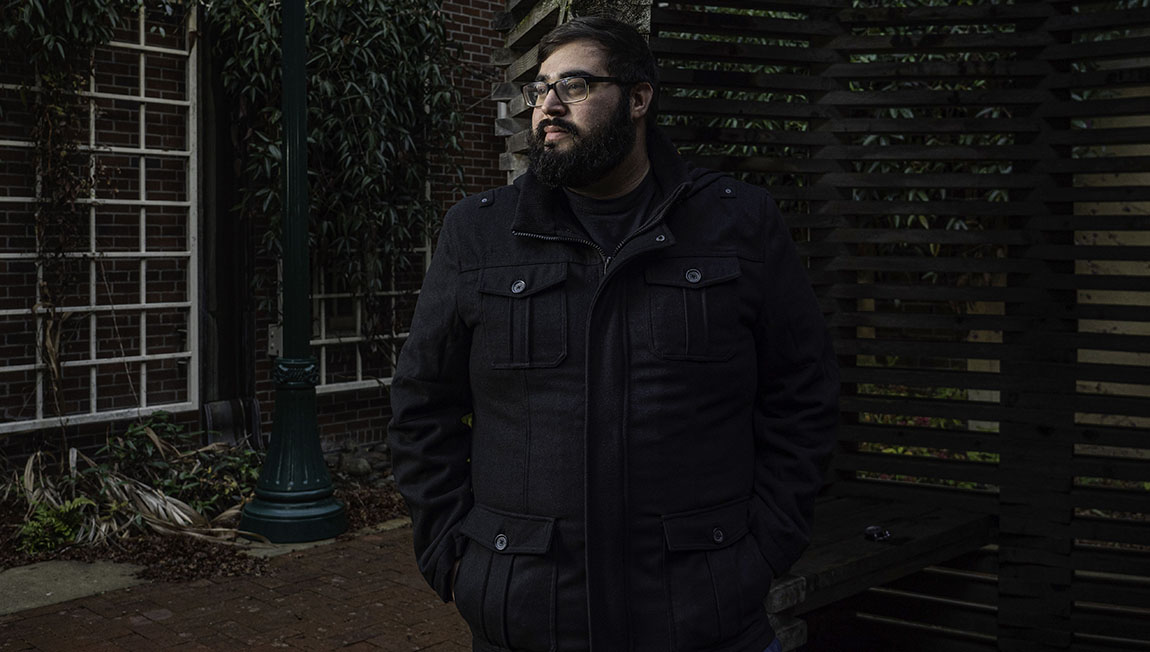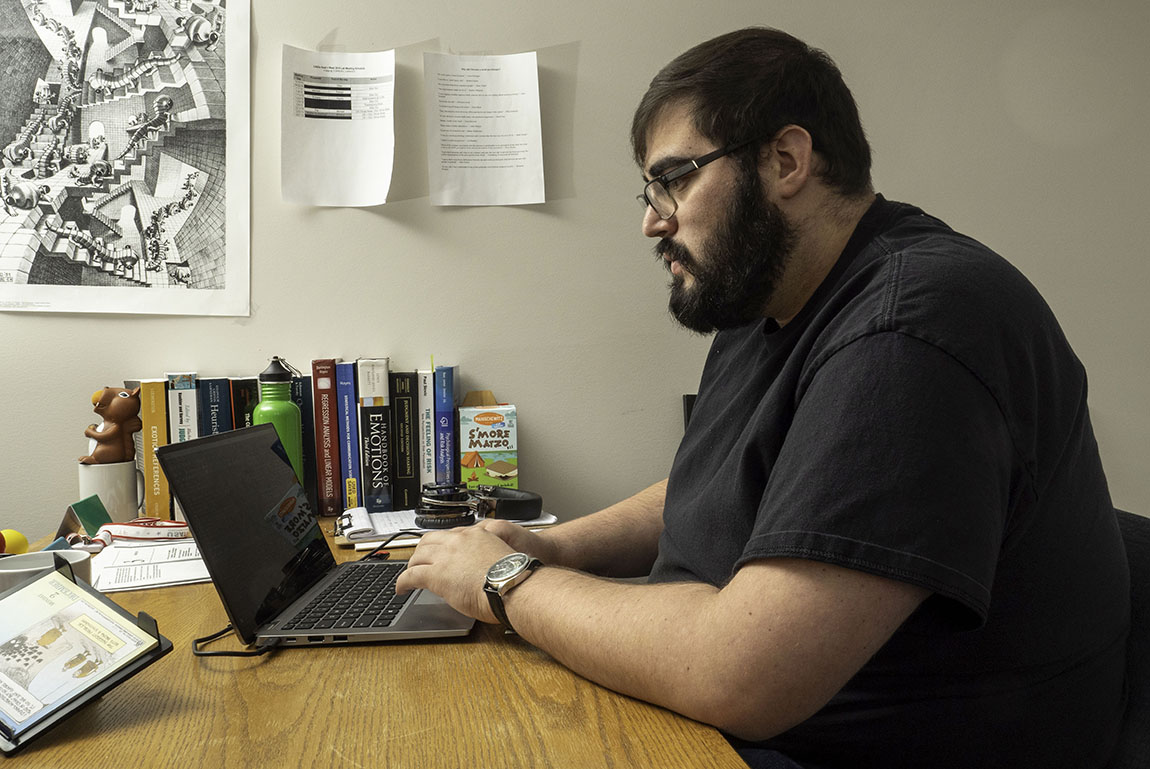Studying the Perceived Risk of Coronavirus
Michael Silverstein ’18 is part of a research team examining public sentiment toward the global pandemic.By: Meghan Kita Wednesday, March 18, 2020 08:45 AM
 Michael Silverstein ’18 on the University of Oregon campus. Photos by Brian Davies.
Michael Silverstein ’18 on the University of Oregon campus. Photos by Brian Davies.As a novel coronavirus spread throughout China and into other nearby countries earlier this year, Michael Silverstein ’18 kept checking the numbers. The Ph.D. student in psychology at the University of Oregon and his colleagues sought out updates multiple times daily to learn how many people had tested positive for the disease (COVID-19) caused by the virus and how many people had died after contracting it.
“It was probably unhealthy the extent at which we were looking at this data,” says Silverstein, who was a psychology major and statistics minor at Muhlenberg.
It wasn’t long before he noticed people outside his academic circle paying attention—the United States confirmed its first case in neighboring Washington state on January 20. And Silverstein, whose primary research interest lies in how people make decisions (with a particular interest in medical decisions), saw a chance to learn something.
“This is a situation that’s sort of unique if we’re interested in studying risk perception, because it’s real and it’s happening right now,” he says. “Usually we study it hypothetically, or we do it after the fact by saying, ‘Think about what you were thinking during this event.’ This was an opportunity to do it in real time.”
On February 6, he approached his mentor, Ellen Peters, about studying risk perception surrounding the new coronavirus. Peters, the director of Oregon’s Center for Science Communication Research, liked the idea, and she knew how to get funding fast: She had conducted studies during the 2008 financial crisis that were supported by a Natural Science Foundation (NSF) Grant for Rapid Response Research.
“We had no idea how the disease was going to evolve in the United States,” Silverstein says. “We thought, ‘This could be the worst it gets.’ We were hoping that was the case. We wanted this to not turn into a pandemic. But we still needed to act quickly to get this project underway.”
That night, Silverstein worked on study design and a grant proposal, which Peters used to begin the submission process the following day. They learned that the NSF recommended them for $187,351 in funding on Tuesday, February 11, and they began running their longitudinal study—which was to include five “waves” of questioning—the following Monday, February 17.
The First Wave of Data
Silverstein, Peters and three colleagues crafted a series of questions to ask respondents from Amazon Mechanical Turk, a platform that allows users to hire other users to do simple tasks. Silverstein says it’s a popular tool among psychological researchers because it’s possible to collect data much more quickly than using in-person subjects. The researchers required respondents to be based in the United States and to be rated well on the platform (to avoid including any bots). The researchers asked questions about things like whether respondents had worried about the coronavirus the previous day, whether they had looked at coronavirus statistics the previous day and what people or entities respondents trusted to reduce their risk. They also included questions to gauge emotional responses toward and risk perceptions of the coronavirus as well as support of different policies in response to the now-pandemic.
The research team hoped to collect 1,500 responses—that’s about the number they had funding to study—but they stopped at 1,300. That’s how many they had when Washington announced the first death in the United States linked to coronavirus on February 29, a moment with great potential to shift the public’s perception of risk: “We thought that was a big enough event that we needed to shut down the first wave of collection,” Silverstein says.
Some of their preliminary findings from the first wave of questions were published on the academic site The Conversation and referred to in an op-ed Peters published in The New York Times Sunday. The gist of The Conversation piece, Silverstein says, is that Americans who identify as conservative are more likely to trust political entities (the president, Congress) to reduce their risk during this pandemic more than liberals are, but that all Americans trust nonpartisan figures most—namely, scientists at the Centers for Disease Control and Prevention (CDC) as well as physicians.

“These findings are important because messages from trusted sources are typically more persuasive. People follow recommendations more when they come from a trusted person or group,” Silverstein and his colleagues wrote on The Conversation. “As a result, when someone you trust tells you to avoid close contact with sick people, not touch your face and cover your coughs and sneezes with a tissue, you are more likely to do so. This suggests that getting messages from nonpartisan experts is more likely to help reduce U.S. and global disease spread.”
Wave Two, and Beyond
The group just wrapped up their second wave of questioning—80 percent of respondents from the first wave returned for the second, a good retention rate—and they’re preparing to analyze that data now. Silverstein will focus on examining the data from the questions regarding emotional responses, perceived risk and beliefs about treatment.
The group is also determining which questions to add when they begin wave three. (Some questions will be asked throughout the study so the group can compare responses over time, while others will be added or subtracted as the situation evolves.)
“This is a very interesting opportunity for us to be able to ask a lot of questions, so we’re all kind of throwing ideas in the pot,” Silverstein says. “We’re trying to prioritize which of these are important to ask while maintaining consistency for the longitudinal study.”
As of now, they’re watching the news for the next big story so they can launch wave three, perhaps if all states shut down nonessential businesses and services as Pennsylvania did this week. Silverstein expects that the fifth and final wave of questioning will take place in June.
However, he says, “should things go a certain direction, I could see us wanting to continue and potentially trying to get more funding.”
